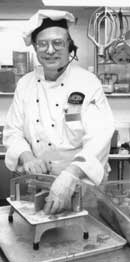Story by Clint Kelly
Photos by Jimi Lott
 Head chef Howard Hilstrom
Head chef Howard Hilstrom

When sophomore Andrew Cox of Eugene, Oregon, returned to campus in September, he received a shock. The old Gwinn Commons dining hall had transformed into "Campus Crossroads, the ultimate dining experience."
"It doesn't seem real," Cox says, amazement ringing in every word. "We returnees had our old image of Gwinn, and no one really believed that we'd come back to this."
"This" is a sparkling $7 million renovation of Gwinn Commons into one of the nation's premier campus dining facilities. The Pacific Northwest décor features natural wood beams and concrete floors, huge windows, and a fireplace for coffee-sipping on a cold winter's eve.
 The food preparation by chefs in tall hats is "out front" at a series of restaurant stations. Diners are enticed by an array of upscale menu selections, including Thai fry with peanut sauce and rosemary gorgonzola fettucine garnished with fresh rosemary. Even the plates and bowls are no longer
institutional white, but have been replaced with sunny fiesta Ware.
The food preparation by chefs in tall hats is "out front" at a series of restaurant stations. Diners are enticed by an array of upscale menu selections, including Thai fry with peanut sauce and rosemary gorgonzola fettucine garnished with fresh rosemary. Even the plates and bowls are no longer
institutional white, but have been replaced with sunny fiesta Ware.
"It's dazzling!" says President Philip Eaton.
On November 19, guests at the official ribbon-cutting and dedication ceremony toured the new state-of-the-art Gwinn. Then they were treated to a gourmet salmon luncheon in the Cascade Room, one of three separate banquet facilities on the third floor that together seat 400 banquet-style or 540 theatre-style.
Among the invited guests were 24 members of the Gwinn family. Wells Gwinn, for whom the dining facility is named, served 32 years on the Seattle Pacific Board of Trustees. Several members of the Teel family, major financial contributors to the Gwinn Commons renovation project, were also present. The President's Dining Room has been named in honor of Ed and Polly Teel, longtime friends and benefactors of the University.
"There are only two or three of these dining facilities in the country," says William Hamman, president of education services for Sodexho Marriott, the company that provides the Seattle Pacific campus with food services. "It was designed by customer feedback specifically for this university culture and meets the individual needs of these students."
And are they ever happy, says sophomore Laura Morse of Pleasanton, California. She has more options than ever before. "The setting is beautiful and from what I hear, people just love it!"
"We're getting excellent feedback," agrees Kerwin Higashi, general manager of campus dining services and member of the renovation team that included Dave Church, executive director of facility and project management, and Jim Korner, executive director of university services. "Customer surveys on a scale of one to 10 average eight or nine all the way through. Our customer counts are up 25-30 percent over last year and guest tickets are way up. I've never seen so many faculty and staff members dining here. We even have people come in from the Queen Anne community."
Lisa Surdyk, associate professor of economics eats in Gwinn once or twice a week. She usually dines with her husband, Tim Surdyk, recently hired as budget and information systems manager in the Provost's Office, and other coworkers. "There's always something good to eat. My favorites are the fajita and the fresh pasta."
Frank Merrow, maintenance operating engineer, feels the same. He's been a Gwinn regular for a long time but says the new facility is a pleasure. "The surroundings are nice and bright. The beef stroganoff casserole is my favorite with chunks of beef, noodles, carrots..."
The most popular menu items tend to be the "comfort foods" such as roast turkey and beef. Gwinn staff members invite customers to submit their favorite family recipes for consideration, and promise that if the recipes should become part of the menu, proper recognition will be given.
 It is small wonder the menu's a hit, says Higashi. Well before the wrecking ball took a swing at the old Gwinn, built in 1962 for a campus population a third of the size it is today, students, faculty, staff and administrators were asked what kind of dining
experience they preferred and what specific dishes were favorites.
It is small wonder the menu's a hit, says Higashi. Well before the wrecking ball took a swing at the old Gwinn, built in 1962 for a campus population a third of the size it is today, students, faculty, staff and administrators were asked what kind of dining
experience they preferred and what specific dishes were favorites.
Higashi took customer satisfaction personally. Members of the renovation team visited cutting-edge dining facilities, including UCLA's. Higashi and his staff analyzed dining trends at popular restaurants among the young, like Red Robin, to study how food is prepared, wrapped and presented. Kitchen design experts were consulted to most efficiently configure the food prep areas, and the staff is trained to keep a constant watch on which items move, which don't, and how the traffic flows. A cashier with headphones alerts each restaurant station as to numbers of customers passing through. "One hundred people in, 25 steakhouse burgers down," says Higashi. "We make it a science."
Safe to say, the new Gwinn Commons - all-you-can-eat, 12 hours a day, with plenty of variety for either the discriminating vegetarian or confirmed carnivore - is not your father's cafeteria.
Editor's Note: Click here to see how you can get a free lunch at the new Gwinn Commons, compliments of Response.
![]()

| Please read our
disclaimer.
Send any questions, comments or correspondence about Response to
jgilnett@spu.edu or call 206-281-2051. Copyright © 2000 University Communications, Seattle Pacific University.
Seattle Pacific University |